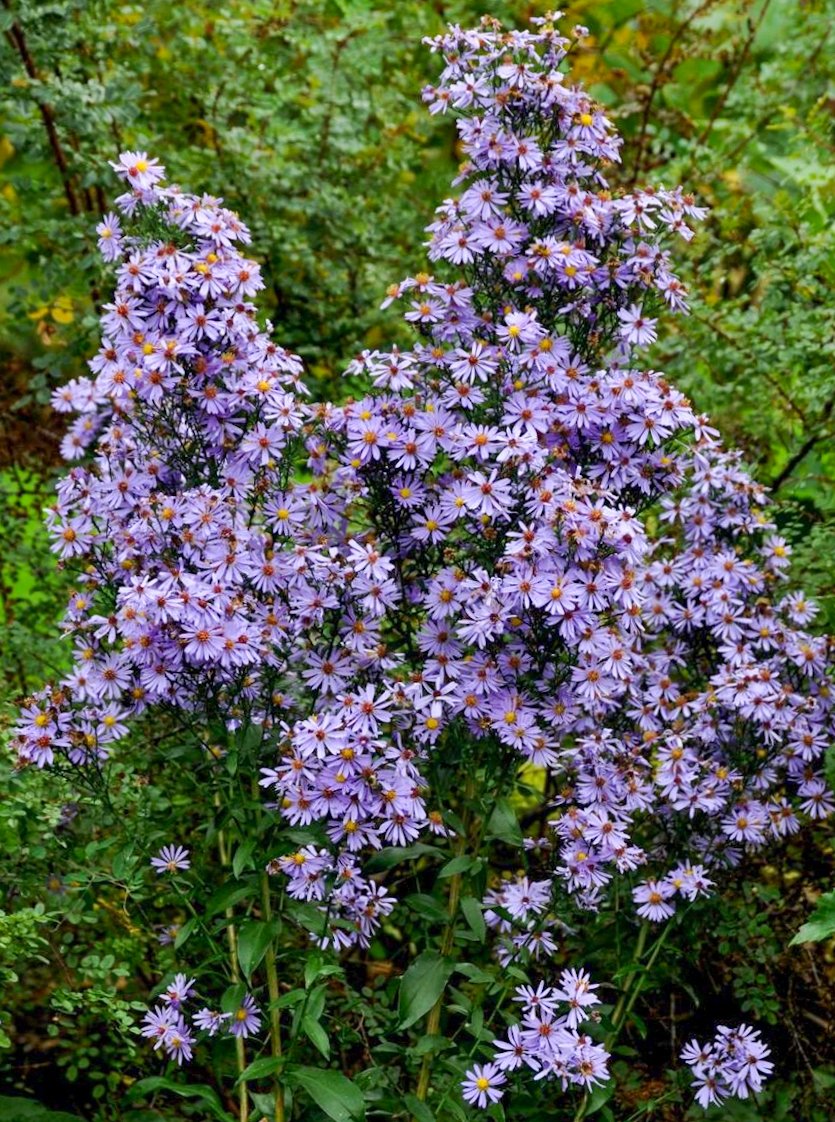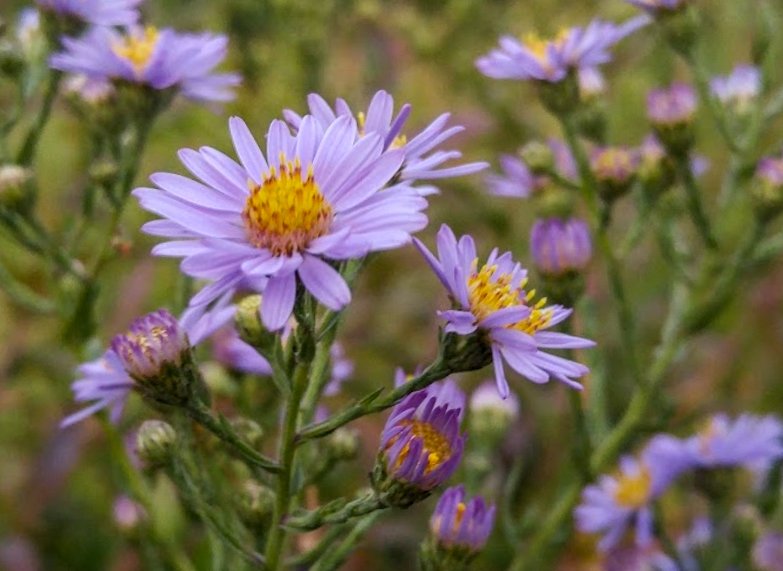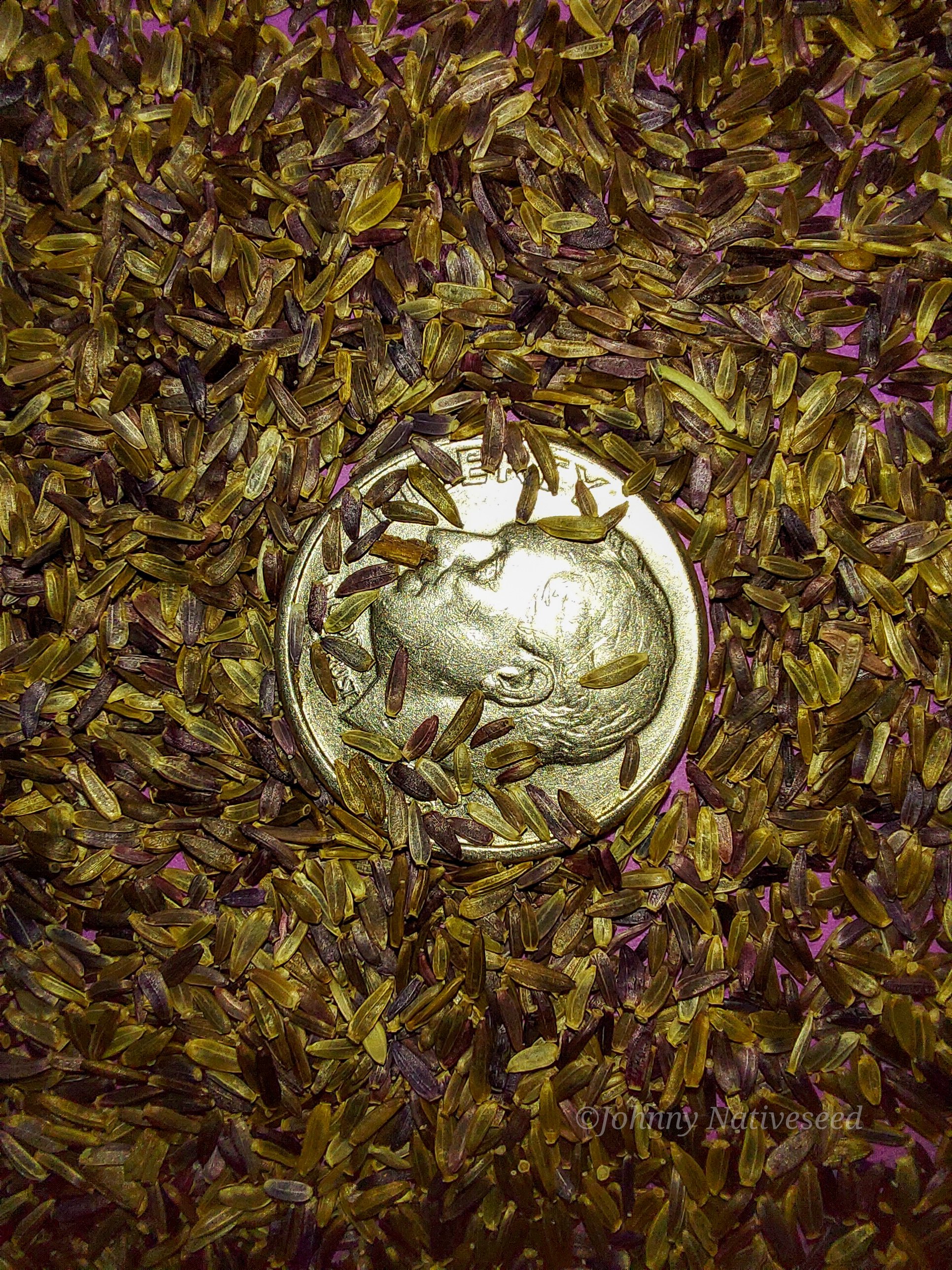Smooth Blue Aster (Symphyotrichum laeve)
Smooth Blue Aster (Symphyotrichum laeve)
Symphyotrichum laeve (formerly Aster laevis), is the scientific name for this valuable flowering plant native to Canada and the United States. It has many regional common names such as the one we use, Smooth Blue Aster, or Smooth Aster, Smooth-leaved Aster, and to lesser degrees, Glaucous Michaelmas-daisy and Glaucous Aster.
As it’s name hints at, the leaves of Smooth Blue Aster are, in fact, smooth to the touch. Often mistaken for Sky Blue Aster (Symphyotrichum oolentangiense), the smooth vs rough leaves is helpful in differentiating the two.
Smooth Blue Aster is exceptionally hardy and can be found growing in fields, open woods, and along roadsides, in rocky or dry soil and in full sun.
Slow to spread through its non aggressive rhizomes, Smooth Blue Aster will anchor in place and develop gentle drifts and colonies as it meanders out from from its place of origin in your pollinator garden.
Smooth Blue Aster is the host plant for the native Pearl Crescent Butterfly, and the Silvery Checkerspot Butterfly
Native to every state but California and is listed as present but rare in several counties of the states of Rhode Island, Vermont, Delaware, Maryland, North Carolina, South Carolina, Georgia, and Florida
Plant Details
USDA Zones: 3-9
Germination Needs: No special treatment needed.
Life Cycle: Perennial
Sun Exposure: Full to Partial
Soil Moisture: Medium-Wet, Medium, Medium-Dry
Plant Spacing: 1½-2 feet
Height: 4 feet
Bloom time: August, September, October
Bloom Color: Blue
Advantages :
Pollinator Favorite: butterflies, moths, bees, wasps, beetles
Bird Favorite: seeds, insects, fruit, nectar, nesting, perchs.
Deer Resistant: Yes
Native to : Wisconsin, Minnesota, Michigan, Iowa, Illinois, Indiana, Ohio, Pennsylvania, New York, Vermont, New Hampshire, Maine, Massachusetts, Rhode Island, Connecticut, Delaware, Maryland, New Jersey, West Virginia, Virginia, Kentucky, Tennessee, North Carolina, South Carolina, Georgia, Alabama, Mississippi, Louisiana, Florida, Texas, Oklahoma, Kansas, Missouri, Arkansas, Nebraska, South Dakota, North Dakota, Montana, Wyoming, Colorado, New Mexico, Arizona, Utah, Nevada, Idaho, Oregon, and Washington.
.
.
Packet quantities:
We pride ourselves on ethical, hands on, ecological management, using no mechanical or chemical methods whatsoever.
All of our native seed is hand reared, hand picked, and hand packed from native prairies under our exclusive management, never breaking chain of custody from the field until it is sent to you. Each packet is hand prepared for shipment by us, directly.
Small seed species will contain greater than 20-25 seed
Large seed species will contain greater than 10-15 seed
It is our mission to spread the wealth of native plant and pollinator ecological sustainability, and educate back yard gardeners as well as corporate and government entities in how to germinate, grow, and benefit from native synergies.
Thank you for your support, it is because of you, that we can grow together to do, what we do.🐛🦋🐝🐞🌾🌱🌼🧡
Smooth Blue Aster (Symphyotrichum laeve)
Symphyotrichum laeve (formerly Aster laevis), is the scientific name for this valuable flowering plant native to Canada and the United States. It has many regional common names such as the one we use, Smooth Blue Aster, or Smooth Aster, Smooth-leaved Aster, and to lesser degrees, Glaucous Michaelmas-daisy and Glaucous Aster.
As it’s name hints at, the leaves of Smooth Blue Aster are, in fact, smooth to the touch. Often mistaken for Sky Blue Aster (Symphyotrichum oolentangiense), the smooth vs rough leaves is helpful in differentiating the two.
Smooth Blue Aster is exceptionally hardy and can be found growing in fields, open woods, and along roadsides, in rocky or dry soil and in full sun.
Slow to spread through its non aggressive rhizomes, Smooth Blue Aster will anchor in place and develop gentle drifts and colonies as it meanders out from from its place of origin in your pollinator garden.
Smooth Blue Aster is the host plant for the native Pearl Crescent Butterfly, and the Silvery Checkerspot Butterfly
Native to every state but California and is listed as present but rare in several counties of the states of Rhode Island, Vermont, Delaware, Maryland, North Carolina, South Carolina, Georgia, and Florida
Plant Details
USDA Zones: 3-9
Germination Needs: No special treatment needed.
Life Cycle: Perennial
Sun Exposure: Full to Partial
Soil Moisture: Medium-Wet, Medium, Medium-Dry
Plant Spacing: 1½-2 feet
Height: 4 feet
Bloom time: August, September, October
Bloom Color: Blue
Advantages :
Pollinator Favorite: butterflies, moths, bees, wasps, beetles
Bird Favorite: seeds, insects, fruit, nectar, nesting, perchs.
Deer Resistant: Yes
Native to : Wisconsin, Minnesota, Michigan, Iowa, Illinois, Indiana, Ohio, Pennsylvania, New York, Vermont, New Hampshire, Maine, Massachusetts, Rhode Island, Connecticut, Delaware, Maryland, New Jersey, West Virginia, Virginia, Kentucky, Tennessee, North Carolina, South Carolina, Georgia, Alabama, Mississippi, Louisiana, Florida, Texas, Oklahoma, Kansas, Missouri, Arkansas, Nebraska, South Dakota, North Dakota, Montana, Wyoming, Colorado, New Mexico, Arizona, Utah, Nevada, Idaho, Oregon, and Washington.
.
.
Packet quantities:
We pride ourselves on ethical, hands on, ecological management, using no mechanical or chemical methods whatsoever.
All of our native seed is hand reared, hand picked, and hand packed from native prairies under our exclusive management, never breaking chain of custody from the field until it is sent to you. Each packet is hand prepared for shipment by us, directly.
Small seed species will contain greater than 20-25 seed
Large seed species will contain greater than 10-15 seed
It is our mission to spread the wealth of native plant and pollinator ecological sustainability, and educate back yard gardeners as well as corporate and government entities in how to germinate, grow, and benefit from native synergies.
Thank you for your support, it is because of you, that we can grow together to do, what we do.🐛🦋🐝🐞🌾🌱🌼🧡
Smooth Blue Aster (Symphyotrichum laeve)
Symphyotrichum laeve (formerly Aster laevis), is the scientific name for this valuable flowering plant native to Canada and the United States. It has many regional common names such as the one we use, Smooth Blue Aster, or Smooth Aster, Smooth-leaved Aster, and to lesser degrees, Glaucous Michaelmas-daisy and Glaucous Aster.
As it’s name hints at, the leaves of Smooth Blue Aster are, in fact, smooth to the touch. Often mistaken for Sky Blue Aster (Symphyotrichum oolentangiense), the smooth vs rough leaves is helpful in differentiating the two.
Smooth Blue Aster is exceptionally hardy and can be found growing in fields, open woods, and along roadsides, in rocky or dry soil and in full sun.
Slow to spread through its non aggressive rhizomes, Smooth Blue Aster will anchor in place and develop gentle drifts and colonies as it meanders out from from its place of origin in your pollinator garden.
Smooth Blue Aster is the host plant for the native Pearl Crescent Butterfly, and the Silvery Checkerspot Butterfly
Native to every state but California and is listed as present but rare in several counties of the states of Rhode Island, Vermont, Delaware, Maryland, North Carolina, South Carolina, Georgia, and Florida
Plant Details
USDA Zones: 3-9
Germination Needs: No special treatment needed.
Life Cycle: Perennial
Sun Exposure: Full to Partial
Soil Moisture: Medium-Wet, Medium, Medium-Dry
Plant Spacing: 1½-2 feet
Height: 4 feet
Bloom time: August, September, October
Bloom Color: Blue
Advantages :
Pollinator Favorite: butterflies, moths, bees, wasps, beetles
Bird Favorite: seeds, insects, fruit, nectar, nesting, perchs.
Deer Resistant: Yes
Native to : Wisconsin, Minnesota, Michigan, Iowa, Illinois, Indiana, Ohio, Pennsylvania, New York, Vermont, New Hampshire, Maine, Massachusetts, Rhode Island, Connecticut, Delaware, Maryland, New Jersey, West Virginia, Virginia, Kentucky, Tennessee, North Carolina, South Carolina, Georgia, Alabama, Mississippi, Louisiana, Florida, Texas, Oklahoma, Kansas, Missouri, Arkansas, Nebraska, South Dakota, North Dakota, Montana, Wyoming, Colorado, New Mexico, Arizona, Utah, Nevada, Idaho, Oregon, and Washington.
.
.
Packet quantities:
We pride ourselves on ethical, hands on, ecological management, using no mechanical or chemical methods whatsoever.
All of our native seed is hand reared, hand picked, and hand packed from native prairies under our exclusive management, never breaking chain of custody from the field until it is sent to you. Each packet is hand prepared for shipment by us, directly.
Small seed species will contain greater than 20-25 seed
Large seed species will contain greater than 10-15 seed
It is our mission to spread the wealth of native plant and pollinator ecological sustainability, and educate back yard gardeners as well as corporate and government entities in how to germinate, grow, and benefit from native synergies.
Thank you for your support, it is because of you, that we can grow together to do, what we do.🐛🦋🐝🐞🌾🌱🌼🧡





